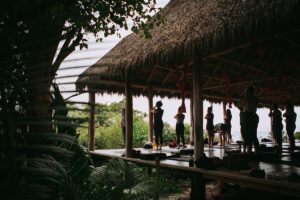In the transformative journey of a yoga retreat, the leader plays a pivotal role far beyond teaching yoga. They are the heart and soul of the experience, tasked with guiding participants through a journey of self-discovery, relaxation, and rejuvenation. This article delves into the multifaceted role of a yoga retreat leader, focusing on the essential skills of effective communication, problem-solving, and setting the right tone and attitude. By mastering these areas, leaders can create an inclusive, supportive, and memorable retreat experience that resonates deeply with all attendees.
Mastering Communication
Effective communication transcends mere dialogue; it’s the lifeline of a yoga retreat, pivotal in shaping an environment where growth, understanding, and connection flourish. The essence lies not just in what is communicated but in how it resonates with and impacts the participants. Through a blend of clarity, empathy, active listening, and adaptability, retreat leaders can master the art of communication, turning each retreat into a journey of collective transformation and individual insight.
Clarity and Empathy in Communication
Imagine a scenario where a participant, let’s call her Maya, feels overwhelmed by a particularly challenging yoga pose. A leader’s clear instruction, coupled with an empathetic tone, can transform Maya’s frustration into a moment of learning and self-compassion. The leader might say, “It’s okay to feel challenged by this pose. Yoga is not about perfection but about embracing where we are at this moment. Let’s try a modified version together.” This approach not only provides clear guidance but also validates Maya’s experience, fostering a supportive atmosphere.
- Practical Tip: Use metaphors or stories to clarify complex concepts during sessions. For example, comparing the balance in a yoga pose to finding balance in life can make the instruction more relatable and meaningful.
Strategies for Active Listening
While on retreat, Alex shares in a group discussion that he’s struggling with meditation, finding it hard to quiet his mind. An active listening response would involve the retreat leader reflecting back Alex’s concern, “It sounds like you’re finding it challenging to find stillness in your meditation, is that right?” This acknowledgment encourages Alex to open up more about his experience, feeling heard and understood.
- Practical Tip: Here’s an idea of group activity you can implement to further develop active listening in your retreat: Conduct a ‘listening circle’ where participants take turns sharing their thoughts on a subject without interruption, and others reflect back what they heard. This exercise promotes empathy and understanding within the group.
Adapting Communication Styles
Consider a retreat attended by people from various backgrounds, including a reserved introvert, Elena, and a gregarious extrovert, Leonard. While Elena might prefer quiet check-ins and written feedback, Leonard thrives on lively group discussions and verbal feedback. Recognizing these differences, a skilled leader adapts their approach, perhaps offering individual sessions for those like Elena and group activities for those like Leonard, ensuring each feels comfortable and valued.
- Practical Tip: Before the retreat, send out a questionnaire to gauge participants’ communication preferences, interests, and cultural backgrounds. This preemptive step can guide how you adapt your communication style to meet diverse needs.
Encouraging Open Dialogue and Feedback
Halfway through the retreat, a feedback session is held. One participant suggests an additional quiet time in the morning for personal reflection. Instead of dismissing this, the leader thanks them for the suggestion and implements a quiet 15 minutes the next day. This action not only shows responsiveness but also encourages a culture of open dialogue, where participants feel their voices matter.
- Exercise: Implement a ‘suggestion box’ where participants can anonymously submit ideas or feedback throughout the retreat. Review these suggestions regularly and, where possible, incorporate them into the retreat programming.
In weaving these communication threads—clarity and empathy, active listening, adaptability, and open dialogue—a retreat leader can create a tapestry of experiences that resonate deeply with each participant. These strategies, enriched with examples and practical exercises, are not just techniques but pathways to fostering a transformative, inclusive, and profoundly connected retreat environment.
Problem-Solving Skills
Problem-solving skills are vital for a yoga retreat leader, acting as the navigational compass through the unpredictable seas of retreat planning and execution. Effective problem-solving not only addresses issues as they arise but, through anticipation and strategic planning, can prevent many problems from occurring in the first place. This skill set ensures a smooth, enjoyable experience for participants and a less stressful one for the organizer.
Anticipating Challenges
Before the retreat even begins, envisioning potential challenges is key. Consider, for instance, the story of a retreat leader who neglected to check the weather forecast, leading to an outdoor yoga session being unexpectedly rained out. Learning from this, the leader now always has a backup indoor space reserved, demonstrating the importance of anticipating and planning for logistical issues.
- Practical Tip: Create a comprehensive checklist that includes all logistical elements, such as transportation, accommodation, meal planning, and weather considerations. Review and update this list for every retreat, learning from past experiences.
- Activity: Conduct a ‘mock retreat’ planning session where you envision worst-case scenarios and brainstorm solutions. This exercise can reveal potential oversights and encourage creative problem-solving.
Participating Briefing to Mitigate Foreseeable Problems
Group dynamics can present another set of challenges, from personality clashes to unmet expectations. An anecdote that illustrates this involved a participant who was vegan but hadn’t informed the retreat leader, leading to mealtime frustrations. Now, detailed dietary preference forms are sent out well in advance, and menus are discussed on the first day to ensure everyone’s needs and expectations are clear and met.
- Practical Tip: Use pre-retreat questionnaires to gather information on dietary restrictions, fitness levels, health issues, and personal goals. This preparation allows you to address potential issues before they arise.
Strategies for Effective Problem-Solving
When issues do arise, having a step-by-step approach is crucial. Take the case of a retreat where a scheduling mix-up led to double-booking yoga studio space. The leader calmly gathered all affected parties, acknowledged the mistake, and worked collaboratively to adjust the schedule in a way that minimized disruption, turning a potential crisis into a lesson in flexibility and adaptability.
Step-by-Step Problem Solving Guide:
- Identify the Problem: Clearly define what the issue is.
- Gather Information: Understand the full scope and implications.
- Brainstorm Solutions: Think of all possible ways to resolve the issue.
- Evaluate Options: Consider the pros and cons of each solution.
- Decide and Implement: Choose the best solution and put it into action.
- Review: Afterward, assess the outcome and what you could do differently next time.
- Case Study: In another instance, a retreat faced an unexpected power outage. The leader used this as an opportunity to introduce candlelit meditation sessions, transforming what could have been a major setback into a unique, memorable experience for participants.
Through anticipation, preparation, and effective problem-solving strategies, yoga retreat leaders can navigate the complexities of retreat planning, turning potential obstacles into opportunities for growth, learning, and even deeper connection among participants. This proactive approach ensures that both the journey and the destination are rewarding for everyone involved.
Setting the Right Tone and Attitude
Setting the right tone and attitude as a yoga retreat leader is akin to a gardener tending to a diverse and vibrant garden. Each participant, like a unique plant, has their own needs, growth pace, and contribution to the ecosystem. The leader’s mood and demeanor act as the sunlight and rain, essential in nurturing a positive, inclusive, and encouraging atmosphere where all can thrive.
Creating a Positive Environment
Consider the story of Lena, a retreat leader who starts each day with a genuine smile and a personal greeting for each participant. This simple act sets a tone of warmth and welcome, making a significant impact on group dynamics. Participants feel valued and are more likely to engage openly with one another, fostering a sense of community.
- Practical Tip: Begin each day with a positive affirmation or gratitude exercise. This can be a shared circle where participants express one thing they’re grateful for. It shifts focus to positivity and cultivates an environment of appreciation and mindfulness.
Techniques for Maintaining a Positive, Inclusive, and Encouraging Atmosphere
To ensure inclusivity, it’s crucial to acknowledge and celebrate the diverse tapestry of participants. Sarah, another retreat leader, makes it a point to learn at least one personal interest of each attendee before the retreat starts. She then incorporates these interests into the retreat activities, whether it’s a nature hike for the outdoor enthusiasts or a silent meditation class for those seeking quiet reflection. This personal touch not only makes the retreat more enjoyable for everyone but also demonstrates a deep respect for individuality.
- Activity: Organize a “get to know you” session where participants can share something about themselves, such as a hobby or a personal goal for the retreat. This helps building connections and also allows you, as a leader, to tailor the retreat experience to better meet the group’s needs.
Accommodating Various Levels of Yoga Practice, Physical Abilities, and Dietary Restrictions
A retreat should be a sanctuary for growth and relaxation, accessible to all, regardless of their yoga proficiency or physical capabilities. This inclusivity was exemplified when Mark, a retreat leader, introduced parallel yoga sessions—one for beginners and one for advanced practitioners—ensuring that each participant could engage at a level comfortable for them without feeling left out or overwhelmed.
- Practical Tip: Always offer modifications for poses and have assistants ready to help participants who might need extra support. Similarly, work closely with the kitchen staff to prepare meals that cater to all dietary restrictions, clearly labeling food options.
Building a Community That Respects and Celebrates Diversity
Celebrating diversity enriches the retreat experience, broadening perspectives and deepening understanding among participants. A memorable example comes from a retreat where the leader, Ana, organized a cultural exchange evening. Participants were invited to share stories, music, or artifacts from their heritage. This not only was an evening of entertainment but also a profound learning experience, highlighting the beauty of diversity and fostering mutual respect and appreciation.
- Exercise: Create a “cultural mosaic” workshop where participants can collaborate on a collective art project, each contributing an element that represents their background or experience. This tangible representation of the retreat’s diversity can serve as a powerful reminder of the community’s interconnectedness and mutual respect.
By setting the right tone and attitude, a yoga retreat leader can cultivate an environment that not only supports personal growth and relaxation but also celebrates the unique journey of each participant. Through thoughtful actions and mindful leadership, the retreat becomes a haven of positivity, inclusivity, and communal harmony.
Building and Maintaining Trust
Building and maintaining trust is the bedrock upon which the transformative experience of a yoga retreat is built. The relationship between a retreat leader and the participants is delicate, requiring a fine balance between professionalism and personal connection. When trust is established from the outset, participants feel safe, open, and ready to embark on their personal journeys of growth and discovery.
The Foundation of Trust
Imagine a retreat where, upon arrival, each participant is greeted by the leader with a warm, personalized welcome. This initial interaction sets a powerful tone. By remembering and using their names, the leader begins to weave the thread of trust. An anecdote that illustrates the depth of this principle involves Jamie, who made it a point to share a brief personal story during the opening circle, highlighting a moment of vulnerability. This act of openness encouraged participants to lower their own barriers, fostering a community of trust and mutual respect from the start.
- Practical Tip: Start the retreat with an opening circle where everyone shares their intentions and fears for the retreat. This not only humanizes the experience but also immediately establishes a culture of openness and trust.
Methods for Establishing Trust from the Outset
Trust is further cemented through consistency and reliability. Let’s consider Alex, a retreat leader known for his punctuality and preparedness. By consistently starting and ending sessions on time and being well-prepared for each activity, Alex communicated respect for his participants’ time and well-being, crucial components of trust.
- Activity: Implement a ‘trust walk’ where participants are paired and take turns being blindfolded, with their partner guiding them through a safe but unfamiliar path. This exercise, rooted in vulnerability and reliance, can powerfully illustrate the importance of trust and care for one another.
Maintaining Boundaries While Being Approachable
A retreat leader’s ability to be both a guide and a confidant without blurring personal boundaries is crucial. This balance was exemplified again by Sara, who maintained an open-door policy during certain hours for participants to come and talk about anything on their minds, from personal growth challenges to feedback about the retreat. However, she was clear about her private time, ensuring she could recharge and be fully present for her students.
- Practical Tip: Clearly communicate your availability to participants, including times when you are taking personal space. This not only respects your boundaries but also models healthy boundary-setting for participants.
Establishing Clear Boundaries That Respect Both Leader and Participant Privacy and Comfort
Effective boundary-setting ensures that both leader and participant privacy and comfort are protected, creating a safe space for everyone. A memorable example involves a leader who established a ‘no gossip’ rule, emphasizing the importance of speaking directly to individuals if there were concerns or conflicts. This rule helped maintain a positive and respectful environment, where trust could flourish without the fear of behind-the-back conversations.
Exercise: Facilitate a workshop on boundaries early in the retreat. Use role-playing to explore scenarios that might arise and discuss how to handle them in ways that respect everyone’s comfort and privacy.
In essence, building and maintaining trust in the yoga retreat setting involves a delicate dance of being open and vulnerable while also maintaining professional boundaries. Through thoughtful actions, clear communication, and a commitment to the well-being of each participant, retreat leaders can create a profound and transformative experience grounded in mutual respect and trust.
Conclusion
The essence of a successful yoga retreat lies not just in the beauty of its location or the structure of its program, but in the quality of leadership. A skilled yoga retreat leader excels in communication, problem-solving, and setting a tone that nurtures growth, harmony, and community. By committing to these principles, leaders can ensure that every retreat is a profound experience, leaving participants refreshed, inspired, and deeply connected to their practice and each other.





